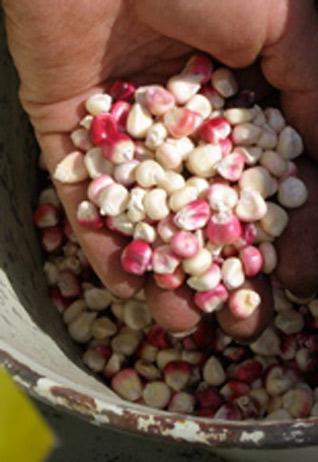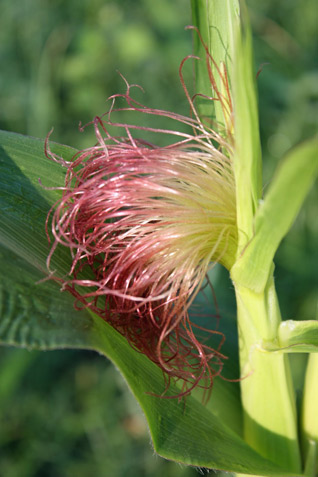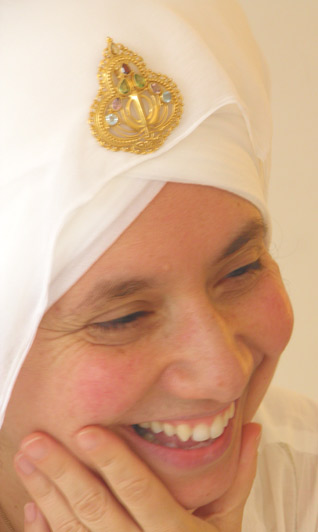Columnists
Hopi Seeds & Seeds of Hope
EK ONG KAAR KAUR
This week we welcome Ek Ong Kaar Kaur to our team as sikhchic.com's new weekly columnist.
Seeds.
They hold the secret of life - the sustaining ability of Mother Earth to carry the results of her experiments from one generation to the next.
Seeds are so small, and yet there is an encyclopedia of instructions within each one. A person can perceive the Cosmology of the entire universe, and the cycle of existence, by looking at a seed.
Back in October 2012, there was a Traditional Agriculture & Sustainable Living conference at Northern New Mexico Community College. The conference organizers brought in some amazing speakers – including Rowen White, Director of the Sierra Seed Cooperative, and Paul Stamets, a dedicated mycologist who studies fungus and mushrooms and how they act as the immune system for the earth’s soil.
It always inspires me to realize how potent, self-renewing and resilient life is. When we begin to touch the power of the earth, it helps us remember the power within ourselves.
At the end of the conference, there was a very humble seed exchange. People brought seeds from their gardens, or they brought pre-packaged seeds. The seeds were left on a table. Then, anyone could pick up any seeds that they liked.
The apricot tree in my backyard had, for the first time in six years, actually borne fruit. Small, palm-sized apricots that were juicy and delicious. I had saved the pits from the fruit and brought them as my offering to the exchange.
There, on the seed-exchange table, was something I had never seen before.
Pink corn!
Lorraine Kahneratokwas Gray of the Four Bridges Traveling Permaculture Institute, had brought a single ear of this corn from her farm in the Espanola valley. The pink color was rich and sweet and it opened my heart. After loosening the seeds off the husk, I took a handful of the corn and brought it home.
I have never tried to grow corn in my life, and the land where I live is harsh. Not much rain. Strong winds. Intense sun in the summer. Growing anything out here is a fight.
But as I began to research the seeds, a new world opened up to me. These were Hopi Pink Corn seeds. Extremely rare. Almost impossible to find over the Internet. But the surprising thing was – the Hopi Indians had bred them to grow in the desert.
Traditionally, the Hopi would use a stick to poke a hole in the ground a foot deep where moisture from the winter snows would still be held by the earth. Then, they would plant multiple seeds in each hole, cover it up and leave it alone. In the desert, with the wind and the sun, the corn stalks would sprout together in clumps – coming up through one foot of earth, and sending deep tap roots down as an anchor.
In this way, the corn grew and gave life to itself and to the Hopi people.
In my mind’s eye, I see the Hopi, with their sticks, planting and praying over the corn. No machines. No chemicals. Just a fierce interdependence with a harsh environment, and a strong will to live. We may be what we eat. But the seeds that we breed reflect our beliefs about the world. And these seeds say, “Life can survive anywhere.”
Learning whatever I could about the corn, I became simultaneously inspired and terrified. It is one thing to plant seeds from a catalogue, and if they don’t “take” this year, you can always try again next year. It is another thing to suddenly find yourself in possession of seeds that are in danger of becoming extinct, with absolutely no experience in how to grow them.
But I am a deep believer that the hand of the Divine moves for a reason. Nothing is a coincidence. So, if the Hopi Pink Corn has come into my life, I have a duty to at least try and sprout it. Even if it ends in failure, I have to try.
I figured what I needed the most was some help from the Guru.
I have heard stories about the Sikhs during the time of the Gurus. It is said that they “made the desert bloom.” Strength. Determination. Rare seeds, themselves. So I asked myself, could there be a shabad in the Guru Granth Sahib that could possibly relate to the planting and cultivating of crops? In some distant past, unrecorded by history, could there be a shabad the farmers may have sung to help their crops grow?
I am a firm believer that plants respond to verbal communication from people. Talking out loud to them. Singing to them. It’s not superstition. They like it.
So I did an electronic search of the Guru Granth, noticing that there is a word which gets translated as “corn” into English. And I came across one shabad by Guru Amar Das, the Third Master, that seemed to fit the bill. If there were any shabads to support the life of a crop, this could have been one.
It is found on page 1281. Here is a poetic interpretation of it.
When the earth is in distress,
It attunes itself with love
And sends out a prayer.
The True One hears it,
And with total ease
Is pleased to give Its strength and steadiness.
It sends a command to the Power of Rain,
And the rain pours down in torrents.
The wealth of grain and corn grows thick.
A person cannot describe its value.
O Nanak, appreciate the Divine Identity.
You, Divine One, cause the life-giving food to be given to all the creatures.
Eating this, peace grows,
And the cycle of pain
Comes no more.
Since finding this particular shabad, I have taken to singing it from time to time with the seeds nearby. I have no idea if the seeds will be successful here, but I have connected with those who can give me guidance about how to grow them. With Guru Amar Das’ shabad in hand, this will give the corn its best shot. Rare seeds need every chance to reproduce. They are the genetic treasure house of the earth.
But the Hopi Pink Corn has me thinking about the Khalsa. And how that way of life, that consciousness, was a rare and resilient seed. It took the Gurus 250 years to cultivate that breed of consciousness, to select for the traits, working tirelessly lifetime after lifetime.
And that rare seed also needs to be preserved … and nurtured.
Just as we are losing the diversity of our food seeds in nature, so are we losing the diversity of how to live life. The Khalsa way of life requires self-discipline -- sometimes, it’s even challenging -- and requires constant commitment.
But like the Hopi Pink Corn, it is capable of survival against incredible odds. It grows deep roots to give life to all.
There are no conclusions to this essay because the story of the Hopi Pink Corn has just begun in my life. Six months from now there could be phenomenal success or heart-breaking failure or anything in between. But this is the process of life. We are given a chance. We are not given a guarantee. And the only real question is – did you take the chance with both hands and do your best?
Because Waheguru ji ki Fateh – victory is Thine -- anyway.
[The author is a writer, a minister of Sikh Dharma and a teacher of Kundalini Yoga, living in New Mexico, USA. She enjoys working with people one-on-one to support their development on both spiritual and practical levels. She also serves as a business and communications consultant for business owners and groups who want to expand in conscious ways.]
March 20. 2013
Conversation about this article
1: Devinder Pal Singh (Delhi, India), March 20, 2013, 6:42 AM.
Beautifully presented, surely it will have a positive follow-up. We eagerly await the sequel.
2: Gurinder Singh (Stockton, California, U.S.A.), March 20, 2013, 11:23 AM.
Very nicely put by Ek Ong Kaar Kaur ji. In my opinion, the birth of the Khalsa was the single most important event in Sikhism. We must nurture and build the institution of the Khalsa. "pargatyo khalsa parmatam ki mauj" -- The Khalsa is the creation of the Lord Himself!
3: Yuktanand Singh (USA), March 20, 2013, 11:39 AM.
What a beautiful way to start a new column! The model of seed and planting resonates with the ecologist, the farmer, as well as the child and the mother in all of us. It is no surprise that gurbani uses this model abundantly for its deeper messages. Several shabads come to mind: "Mind is the farmer, conduct the farming, modesty the water, and body the field" [GGS:595.10]; "How can a seed germinate if it was missing the embryo?" [GGS:468.16]; and, "Gursikhs plant the seed of the Lord's ambrosial nectar, and they gather the Lord's ambrosial naam as its ambrosial fruit" [GGS:304.8].
4: Harman Singh (California, USA), March 20, 2013, 3:39 PM.
What an inspirational and thought-provoking read indeed!
5: Amrit Kaur (London, United Kingdom), March 20, 2013, 4:41 PM.
Your words have stirred something deep within me. You are blessed with both language and insight. I am glad you'll be writing here regularly. Welcome to the world of sikhchic.com!
6: Sarjit Kaur (Bethel Park, Pennsylvania, U.S.A.), March 20, 2013, 7:53 PM.
Amazing gurshabad choice, inspirational article ... and a blessed gursikh indeed. We Sikhs are very blessed indeed! "When the earth is in distress, / It attunes itself with love / And sends out a prayer. The True One hears it, / And with total ease / Is pleased to give Its strength and steadiness. It sends a command to the Power of Rain, / And the rain pours down in torrents. / The wealth of grain and corn grows thick. / A person cannot describe its value. / O Nanak, appreciate the Divine Identity. / You, Divine One, cause the life-giving food to be given to all the creatures. / Eating this, peace grows, / And the cycle of pain / Comes no more."
7: Jai Singh (Mumbai, India), March 20, 2013, 9:09 PM.
Second only to the metaphor of God as friend and lover, is the use of the farming image in Guru Granth Sahib. Naam bovo bovo ... Sow, O sow the seed of naam, goes the shabad. Ek Ong Kaar ji, you've hit the nail on the head! Thank you for your lovely piece.
8: Hari Singh (Kalala, Barnala, Punjab.), March 20, 2013, 9:55 PM.
Wonderful, that Ek Ong Kaar Kaur ji will be writing for us all, the sikhchic.com family. True, the Khalsa shall overcome all odds because it is the creation of the Guru!
9: Upkar Singh (Chandigarh, Punjab), March 22, 2013, 10:33 AM.
The farmer's ethic and vocation have always been considered by the truly learned and pious to be of the highest calling ... certainly way above that of the 'priest' or the 'scholar'. That is why the Great Farmer, Nanak, and those who stepped in his shoes, have relied on the description of his chores and duties to convey to us the ideal life-style of a Sikh. Not unlike Jesus' repeated references to the fisherman.
10: Imaan Kaur (San Diego, California, USA), March 22, 2013, 11:33 AM.
Great writing. I really liked how you brought together seemingly unconnected things and made sense out of their hidden commonality and connectedness. Look forward to your next piece eagerly.
11: Shakil (USA), July 31, 2013, 6:55 AM.
The farmer's ethic and vocation have always been considered by the truly learned and pious to be of the highest calling ... certainly way above that of the 'priest' or the 'scholar'.





